Evangelical Lutheran Church of São Paulo
The Evangelical Lutheran Church of São Paulo (Portuguese: Igreja Evangélica Luterana de São Paulo), also known as Martin Luther Church, is one of the headquarters of the Southeast Synod of the Evangelical Church of Lutheran Confession in Brazil, located near the Largo do Paissandú, in Historic Center of São Paulo. The temple was founded on December 25, 1908, being one of the main meeting places of the German community in the first half of the twentieth century.[1]
| Lutheran Church of São Paulo | |
|---|---|
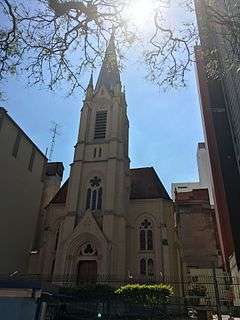 The church in 2016 | |
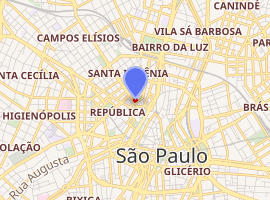
| |
| General information | |
| Architectural style | Neogothic |
| Town or city | São Paulo |
| Country | Brazil |
| Construction started | 1907 |
| Completed | 1909 |
| Destroyed | 1 May 2018 |
| Height | 40 m |
| Technical details | |
| Structural system | Ruin |
| Floor count | 4 |
Initially, it was called by the German name Stadtkirche, being later known as Mother Church and then, only in 1991, being baptized as Martin Luther Church. It is considered the first evangelical Lutheran parish in the city of São Paulo, as well as the first temple in the Neogothic style to be built in the city.[1]
History
The evangelical Lutheran community that lived in São Paulo since the beginning of the nineteenth century was organized autonomously,[2] without the initial presence of pastors. The group had difficulties during the course of the 1800s due to the Catholic regime that existed in Brazil.
The first meeting of the German Lutheran community in São Paulo occurred on December 26, 1858, at the drugstore Ao Veado d'Ouro.[3] The ceremonies were performed in the German language, due to the large number of Germans among the visitors, who were attended by pastors of Rio Claro and Campinas until 1871, when Pastor Emil Bamberg founded the first Evangelical Lutheran community in São Paulo, "Egreja Evangélica Alleman".
Beginning November 15, 1889, with the Proclamation of the Republic of Brazil and the separation of the State and the church, members of the Evangelical Lutheran community had more freedom for the development of religion. On October 29, 1891, Pastor Emil Bamberg was able to organize the community, which initially brought together 80 families. The registration of the statutes of the religious association, however, was only published in 1907.[2]
While Lutheran evangelicals raised donations for the construction of the first temple in São Paulo, the services were also held in a Presbyterian Church.[3]
Construction
In 1906, the brothers Daniel and Hermann Heydenreich donated a land in the then street Visconde of the White River, nº 10 and 12 (current Rio Branco Avenue, nº 34).[4] The donation record only occurred on April 3, 1907, 11 days before the foundation stone was laid.[5] The work was completed only on November 28, 1909, and was the scene of worship in the Evangelical Lutheran community before the end of construction.
Inauguration
In August 1908, the church's pastoral house, at the bottom of the land, was inaugurated with the creation of an administrative office. Four months later, on December 25, 1908, in the midst of the Christmas celebration, the Martin Luther church was inaugurated, then named Stadtkirche in German, which means "City Church."[5]
During the festival, there were Christmas carols chanted by a choir, honored by about five hundred people. Bells, also donated by the Heydenreich brothers, were sounded in the middle of the ceremony.[6] With the completion of the work only on November 28, 1909, was also organized a party, with the presence of pastors of the Rio de Janeiro, Campinas, Rio Claro, of Santos and Petrópolis.
First World War
In the midst of World War I (1914-1918), the Evangelical Lutheran community, predominantly of German origin, had difficulty staying in the capital of São Paulo,[2] due precisely to the proximity to Germany, which was part of the Triple Alliance and ended up being defeated in the conflict.
In 1917, the Brazilian government broke off relations with German and, shortly afterwards, in São Paulo, the celebration of cults in celebration for the 400 years of the Protestant Reformation was prohibited. In the following years, without the money received by the German community, the Evangelical Lutheran church suffered with a strong financial crisis.[5]
Second World War
New problems arise with the beginning of World War II (1939-1945), with Brazil breaking relations once again with Germany, and in 1943, with the sending of Brazilian troops to fight against the Axis powers.[7] During this period, by the determination of the then president Getúlio Vargas, the celebrations could no longer be performed in German. The introduction of Portuguese, however, generated a strong integration of the community with Brazilians.[3][7]
Architectural features
The Martin Luther Church was designed by the architect "Guilherme von Eÿe", also responsible for the construction of the São Paulo Conservatory of Dramatic and Musical Conservatory. He completed the temple project in February 1907.[1]
First building built in the neogothic style in São Paulo,[3] the temple sits in an area of just over 1012 square meters and has a ground floor area of 465 square meters.[1] The church has a unique tower, which is centralized to the main facade. The main access of the church is through a wooden door with two leaves.
Reform
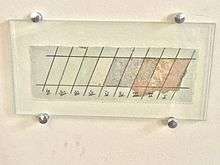
Between 2012 and 2013, the Martin Luther Church underwent an internal reform. A large study was conducted by Companhia do Restauro[8] to retake the initial characteristics of the church, according to what the Municipal Council of Preservation of the Historical, Cultural and Environmental Patrimony of the City of São Paulo determined.[9] Due to lack of money, the restoration could not be made in the outer area of the temple.[3] The Lutheran Church of São Paulo tried to get support from Rouanet Law, but could not have access to the economic incentive.
Organ
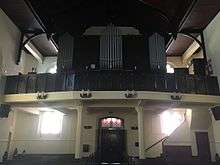
In 1909 was inaugurated in the church an organ constructed by the Walcker House that, originally, had 12 registries and 620 pipes. The instrument was reformed in 1956, when the number of pipes passed to 1,090 pipes. New extension in 1995, made by the organist Ricardo Clerice,[10] caused the organ to reach the current 1,146 pipes.[11]
Stained glass
The Martin Luther Church has stained glass, produced by Casa Conrado,[12] of the stained glass artist Conrado Sorgenicht, who produced the pieces of the Market and the Municipal Theater of São Paulo.[13] In the temple of the Rio Branco avenue, the stained glass exposes the Luther Seal and passages of the gospel.
Historical significance
The Martin Luther Church was a symbol for the settlement of the German community in St. Paul and for the union of the Lutherans in the city. No matter how many groups already existed in the neighborhoods of Vila Ema, Vila elina, Vila Prudente and Santo Amaro,[5] the church of the Center became the religious symbol of that town, that already divided spaces like Deutsch Schule (German School), that soon became the Visconde College of Porto Seguro[14] and the Sport Club Germánia (current Sport Clube Pinheiros), since the mid-nineteenth century.
Despite the difficulties of the two world wars, the temple became a reference for Lutheran evangelicals in the city of São Paulo.[7]
Heritage
The Church Martin Luther was registered in 1992 by the Municipal Council of Preservation of the Historical, Cultural and Environmental Patrimony of the City of São Paulo[1] and in 2012 by Conselho de Defesa do Patrimônio Histórico, Arqueológico, Artístico e Turístico[15] of the State of São Paulo. The temple is under Protection Level 1, which requires the integral preservation of the good.
Current state
Currently, Martin Luther Church is in the midst of busy buildings of large stature,[16] which have been occupied by homeless people, and have problems with serious external malfunctions due to time and vandalism. The temple continues to be a meeting place of the German community in São Paulo, but has suffered with the reduction and aging of the faithful. The difficulties also appear due to the large number of evangelical churches in the city, which caused the spreading of the regulars.[17]
In addition to the services that take place every Sunday, the Church organizes every Friday a snack for street dwellers in the central region of São Paulo, who can register and keep the documents in the temple to avoid losses and breakdowns.[18]
Collapse
At dawn on May 1, 2018, a fire occurred at Edifício Wilton Paes de Almeida, a building, occupied by homeless people, located alongside the church. The building collapsed and destroyed part of the church, including most of the stained glass and other historical pieces.[19]
Reconstruction
The Lutheran Church is to spend more than R$ 4 million to rebuild 80% of the destroyed structure commencing on May 1, 2018. Work began on March 27. A piano was also damaged and a German pipe organ of 1908, valued at R$1 million and that was in the mezzanine, had minor breakdowns. For safety, the musical instrument was disassembled and will only be returned to the place after completion of the reconstruction. With 30% of the total amount for reconstruction collected by the church, something around R$1.7 million, the first of the four phases of the works began in March. The money was obtained through property insurance and donations from the faithful. The first stage of the work consists of strengthening the foundations, rebuilding the side wall, roof and lining, stained glass frame and mooring of the altar. In the other stages are planned the revision of the structure of the tower and the reconstruction of stained glass, benches, chandeliers and other items of the church.[20]
Gallery
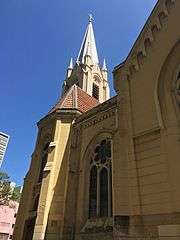 Rear view of Martin Luther Lutheran Church front tower
Rear view of Martin Luther Lutheran Church front tower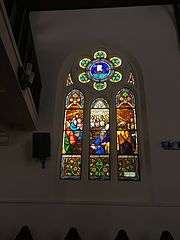 One of the stained glass windows of the Martin Luther Church, depicting Pentecost, produced by the Conrad House
One of the stained glass windows of the Martin Luther Church, depicting Pentecost, produced by the Conrad House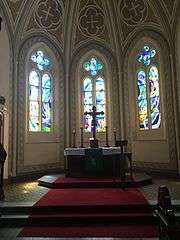 Altar of Igreja Martin Luther
Altar of Igreja Martin Luther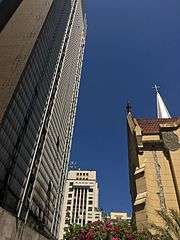 Martin Luther Church dividing space with building in the center of São Paulo
Martin Luther Church dividing space with building in the center of São Paulo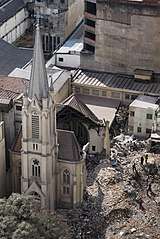 Evangelical Lutheran Church of São Paulo, which collapsed along with the Wilton Paes de Almeida building in Largo do Paissandu
Evangelical Lutheran Church of São Paulo, which collapsed along with the Wilton Paes de Almeida building in Largo do Paissandu
| Wikimedia Commons has media related to Igreja Evangélica Luterana de São Paulo. |
References
- Processo de Tombamento pelo Conpresp - Resolução 37/91-71. p. 2l
- Araújo, Cristiane (2007). Âncora (ed.). Impressão do Espaço Sagrado: a centenária Igreja Evangélica de Confissão Luterana em São Paulo. p. 10.
- Cardoso, Mônica (23 December 2008). ""Templo Luterano em São Paulo completa 100 anos"". Retrieved 19 October 2016.
- Primeiro Cartório de Imóveis da Capital - nº 45904 - livro 3-A-J-40, 1ª série
- Araújo, Cristiane (2007). Âncora (ed.). Impressão do Espaço Sagrado: a centenária Igreja Evangélica de Confissão Luterana em São Paulo. p. 11.
- Begrich, Martin (1962). São Paulo Sinodo evangélico do brasil central 1962 (ed.). Jubiläums-Festschrift zur Wiederkehr des 50. Gründungstages der Mittelbrasilianischen Synode am 28./30. Juni 1912. p. 55.
- Araújo, Cristiane (2007). Âncora (ed.). Impressão do Espaço Sagrado: a centenária Igreja Evangélica de Confissão Luterana em São Paulo. p. 12.
- Ditolvo, Ana Marta (2011). Unicamp (ed.). MESTRADO: Procedimentos Investigativos no Projeto de Restauro Arquitetônico: Análise do Caso Paulistano - Quatro Estudos de Casos. p. 46.
- Ata da 531ª Reunião Ordinária do Conpresp. p. 3
- ":: Clerice :: Organização". www.rclerice.com.br. Archived from the original on 2016-11-23. Retrieved 2016-11-23.
- "die Söhne". www.walcker.com. Retrieved 2016-11-23.
- "A rota dos vitrais: as obras da Casa Conrado | VEJA São Paulo". VEJA São Paulo.
- Araújo, Cristiane (2007). Impressão do Espaço Sagrado: a centenária Igreja Evangélica de Confissão Luterana em São Paulo. Âncora. pp. 25–26.
- Donato, Hernâni (1993). Empresa das Artes (ed.). Colégio Visconde de Porto Seguro: ponte entre duas culturas 1878 - 1993. São Paulo. pp. 26–27.
- Ata da Sessão Ordinária 1658ª do Condephaat. p. 46. Archived 2013-05-12 at the Wayback Machine
- Ditolvo, Ana Marta (2011). MESTRADO: Procedimentos Investigativos no Projeto de Restauro Arquitetônico: Análise do Caso Paulistano - Quatro Estudos de Casos. Unicamp. p. 64.
- "São Paulo viu pulverização evangélica na última década, mostra Censo 2010 - São Paulo - Estadão". Estadão.
- Luteranos, Portal. "Portal Luteranos | Portas abertas para as dores da rua". Portal Luteranos.
- Chris Kitching (May 1, 2018). "Tower block in Brazil collapses leaving at least one dead after massive fire tore through 26-storey building". Daily Mirror. Retrieved May 7, 2018.
- "Um ano após queda de prédio no Centro de SP, igreja atingida começa a ser reconstruída" (in Portuguese). G1. Retrieved April 30, 2019.